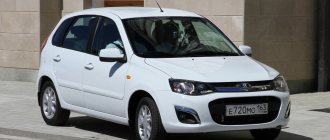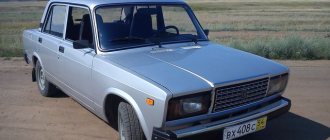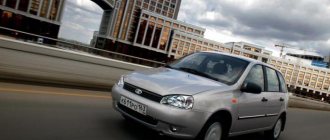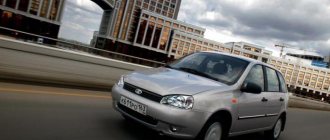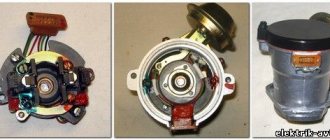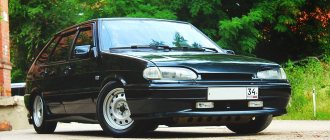In 1996, AvtoVAZ developed and introduced the new 2110 sedan. It is also known as the Lada 110, or “ten”. This is the first post-Soviet car that looks like a foreign car. Like all new production cars, the “ten” was not without various modifications. One of them is 21103, released in 1997. It is often compared with the modification of the VAZ 21104. After all, the VAZ 21104 and 21103 are almost identical, despite the fact that the 21104 began to be produced only in 2004. The main common feature: the presence of a 16-valve injection engine.
Let's look at the technical characteristics, parameters and distinctive features of the VAZ 21103 from other modifications of the VAZ 2110. Let's find out what the advantages and disadvantages of a larger number of valves in the cylinders are. VAZ 21103 and 21104 are no longer produced today, but despite this, the description of the characteristics will be useful for those wishing to purchase a car or current owners.
Model 21103 - “new” line 110
The VAZ 211103 model is the third modification of the 110 line. The oldest “brother” of this model is the first version of the Lada 2110 with an 8-valve carburetor engine, launched into production in 1996. Then, in the same 1996, the country saw the second modification of the VAZ 21102, which was designed to introduce injection engines into the line. But the number of valves still remained 8. And in 1997, the VAZ 21103 car with a sixteen-valve injection power unit was released.
In addition to the engine, version 21103 has the following innovations compared to its predecessors:
- ABS system;
- air conditioner;
- power steering.
Galvanized body, ventilated brakes, new gasoline vapor recovery system and air-conditioned interior. All these opportunities are real know-how for the Russian automotive industry in 1997. Additional trim levels also included power windows, metallic paint, 14-inch alloy wheels, and even an on-board computer.
Interior
When starting to create the interior, the designers took into account some of the shortcomings of previous models and corrected them. Now the driver sits behind the wheel with his legs extended, and not as before, with his legs bent. The steering wheel itself has also changed its appearance, it has become much more beautiful. It has two points of support for the hands with a pillow, and it no longer blocks the visibility of the instruments. The designers have used soft plastic in the dashboard, which looks beautiful and feels good to the touch.
Thanks to this, the likelihood of any noise and squeaks is reduced. In new models, all large mechanical buttons are located on the sides of the dashboard. Climate control is intuitive.
The steering column has the ability to adjust the angle of vertical tilt and has a hydraulic booster. But, despite the updated steering wheel, its rim itself seems too thin to most. The rear seats are quite comfortable, but for three passengers it will already be a bit cramped. The luggage compartment has a volume of 480 liters.
The “Norma” package has front electric windows (it doesn’t matter whether there is a servo drive or not, they do not fully lower into the door), velor upholstery for seats and doors, as well as headrests on the rear sofa. The most expensive “Lux” configuration already has an on-board computer, heated rear-view mirrors and heated seats installed in the front.
The keys installed on the sides of the instrument panel make it impossible to forget that the car began to be designed back in the 1980s. Fuses and relays for the most important options of the car are located inside the car, on the left side under the steering wheel, which is very convenient.
In the famous “Samara” everything was not so convenient. We thought about loading narrow, long things - for this, the middle back of the rear sofa can be fully reclined, and the backs of the rear seats can also be reclined, but at a smaller angle.
Despite the still fairly limited space inside the car, updates to the front fascia and other elements have had a positive impact on the ergonomics of the cabin, which in turn has encouraged many consumers to buy the 2110.
The outside door handle is much better. The tongue from the famous “eight” disappeared, and now the door began to open by simply moving the lever up. Speaking about the doorway, it is worth saying that it has become quite convenient based on the width, but it is too small in height. Not to say that this will interfere, but the lack of headroom is noticeable.
However, the door itself no longer raises any complaints, partly thanks to the sharp upper corner. People of average height have no reason to be afraid, but those who are a little taller should be careful, as they can easily run into him.
In addition, the designers limited the opening angle of the door, which has only one intermediate fixed position. I was pleased that the threshold, which in 2108 was always covered with a layer of dirt in bad weather, now, thanks to the design features, always remains clean.
This point is very important, since when getting into a car you can easily get your clothes dirty if their edges touch the threshold. The driver is presented with a different dashboard, on which there is no longer the “oak” molded plastic - now the panel is made of soft elements reminiscent of the materials used in the VAZ “classic”.
Almost everywhere has become a little more comfortable thanks to the new upholstery of the chairs and the fleecy ceiling. Only the door trim remained molded, however, and it, in turn, became of higher quality.
Some nice touches include height-adjustable seat belts and door locking with central locking. The driver's seat has become more comfortable. The pillow and backrest were increased in width and began to distribute the load better.
You can no longer find that cushion in the lumbar region that bothers drivers, which was on the “eights”. Of course, there was no lateral support before and there is none now. The chair is still adjustable in only two positions, and the adjustments are still mechanical.
The gearshift lever of the VAZ 2110 was lengthened, which may be explained by the desire to reduce the effort when changing gears. The most important sensors - the speedometer and tachometer - now occupied the required space in the central part of the dashboard, and the direction indicators began to be placed on the sides. The center console has acquired indicators for the on-board control system.
Comparison of injection units
The VAZ 21103 operating manual indicates the following engine characteristics.
| Aspects | Options |
| Volume | 1.5 l |
| Maximum power | 94 l. With. (achieved when the crankshaft reaches 5600 rpm.) |
| Limit torque | 130 Nm (possible at 3600 rpm) |
| Number of cylinders | 4 (in-line arrangement) |
| Number of valves | 16 |
| Fuel supply system | Injection |
| Gasoline injection | Distributed |
| Compression ratio | 9,8 |
| Cylinder diameter | 82 mm |
| Piston stroke | 71 mm |
The VAZ 21104 operating manual prescribes parameters slightly different from the above. The engine volume is 100 ml larger and is 1.6 liters. Peak power is 98 hp. With. and is possible already at 5000 rpm. Torque is increased by 1 Nm, but to achieve it, the rotation speed must be increased by 100 rpm. more. The piston stroke has been increased by 4.6 mm, and accordingly the compression ratio has become 0.5 more.
Both the Lada 1103 model and the 1104 version are equipped with 16-valve injection engines.
Safety
The Russian VAZ-2110 car was also crash tested. The result of the checks carried out in Togliatti turned out to be quite good, when compared with Volga, which, out of the available 16 points, was able to get only a meager 2.
After the frontal impact, the front driver's door was in place, and there was not even a single crease on it, and the windshield pillar was only slightly bent. However, the front door did not open due to the fact that she had propped the back door open. This is not a hopeless option, because it is possible to leave the car using the right door.
But what happens to the mannequins? The sensors that were installed on them did not show any life-threatening overloads! Despite the fact that the driver roughly hit the steering wheel and the dashboard, and the passenger sitting next to him hit the front panel, the head injury rate does not exceed the safe limit - 650 units.
This makes it possible to conclude that the probability of getting a head injury in people who are wearing a seat belt is less than 5%. The important advantages of the sedan were confirmed - the strong power structure of the interior. The conclusion is the following - before soft-boiled, but the interior is intact. This was achieved thanks to safety bars that were welded into the front doors. The material of the beams is not light planks, but steel pipes.
The seat slides were also able to withstand the collision, again not on their own, but thanks to the modernized profiles of the retainer teeth. A small load when the dummy's head collides with the steering wheel was achieved because VAZ made it injury-proof.
The corners of the visor were rounded, and the front panel was made of soft plastic. But there were obvious large overloads on the chest from the seat belts, so the calibrated spring was compressed by 0.40 cm, and in the chest of the passenger sitting next to it by 0.45 cm.
This is partly due to the lack of an airbag, which would soften the result of a sudden and rough stop of the car. So, the load exceeds 800 kg.
On the 10, the steering wheel was shifted slightly back and up (0.95 and 0.45 cm, respectively). Moreover, the steering wheel moved to the right by 1.10 cm, and this is already exceeding the qualifying EuroCAP lateral movement limit.
Regarding the legs, there is a great danger of damaging them. For example, the right leg bears an impact of 730 kilograms. Even the pedals exceeded the permissible threshold - they went back by 205 mm, and according to European standards, a pedal offset of more than 200 mm is already a critical indicator.
Based on the results of calculations and summing up the results, the VAZ-2110 scored 4 points, which is twice as high as the Volga 3110, and the same as Svyatogor. If we talk about what the top ten lacks, these are modern seat belts, airbags, body modifications, changes to the lower part of the front panel and other pedals.
Crash test
Modifications
- VAZ-21100 - eight-valve carburetor, the volume of which is 1.5 liters (produced from 1996-2000);
- VAZ-21101 - eight-valve, the volume of which is 1.6 liters;
- VAZ-21102 – eight-valve, volume 1.5 liters;
- VAZ-21103 – sixteen-valve engine, the volume of which is 1.5 liters;
- VAZ-21104 - sixteen-valve power unit, volume 1.6 liters;
- VAZ-21106 – Engine from Opel GTI 2.0 16V – 2.0-liter sixteen-valve engine, developing 150 horsepower and capable of reaching a top speed of 205 km/h. The VAZ 21106 reaches the initial hundred kilometers per hour in 9.5 seconds;
- VAZ-21106s – created on the VAZ-21106 platform. The technical details are the same as for the VAZ 21106. It has the following modification: power steering, a unique interior, an electric sunroof, fog lights and a disc brake system, which was installed not only on the front wheels, but also on the rear;
- VAZ-21107 is a car with a sixteen-valve two-liter Opel engine, which is designed on the 21106 platform. This model was tuned for a sporty driving style, championships and rallies;
- VAZ-21108 - “Premier” - a version of the Russian sedan, which was slightly lengthened;
- VAZ-21103;
- VAZ-21109 – “Consul” is a four-seater limousine with an engine capacity of 1.5 liters. It reaches 5 meters in length;
- VAZ-2110-91 – “Rotor-Sport”. Production started in 1996 and ended in 2004. A 1.3-liter rotary piston power unit was used. This type of car is the fastest among its “family”. The maximum speed reaches 240 km/h. Reaches the first hundred in just 6 seconds. The car is tuned for circuit racing.
Pros and cons of a 16-valve engine
The basic version and the first modification 21002 were equipped with 8-valve engines, that is, each cylinder had 2 holes (intake and exhaust). These units were equipped with a single camshaft driven by a belt or chain. This ensures simplicity of design. Therefore, for the first Lada 110 models, repairs by yourself are much easier. If there is a repair manual, you don’t have to resort to the help of service station workers.
The 8-valve design does not have automatic hydraulic compensators. This allows you to use cheaper gasoline and oil. In the 16-valve injection engine of the VAZ 21103, repairs are ensured in a short time if you fill in inappropriate fuels and lubricants. After all, foreign impurities in a short period of time can form carbon deposits on hydraulic compensators, which will render them inoperable. True, manual adjustment of the thermal clearances of an 8-valve engine takes time. In addition, such an engine can make unnecessary noise.
The advantages of the 8V engine include the small dimensions of the intake system; these elements do not block access to attachments. But in the case of VAZ 21103 and VAZ 21104, repairing the generator or starter is difficult due to the dimensional parts of the intake system. This fact has been repeatedly confirmed by service station specialists who often repair components and assemblies of the VAZ 2110.
But the most important advantage of the 16-valve engine, which outweighs the disadvantages, is dynamics. The total cross-section of 4 holes is in any case greater than the cross-section of 2 valves in one cylinder. Therefore, the fuel-air mixture in an eight-valve engine is injected more slowly, and more time is spent releasing exhaust gases. The dynamics of the car directly depend on these two phases of engine operation. After all, the slower gasoline enters the cylinders, the longer the VAZ engine takes to gain momentum. The larger intake system provides less noise and vibration for a more enjoyable ride.
In addition, hydraulic compensators, although dimensional, regulate thermal clearances automatically. The VAZ 21104 user manual does not have a separate section on manually adjusting thermal clearances. Because such a procedure with 16 valves is very complicated. If you make a mistake, you can throw off the optimal gap settings and complicate your repair. The 16V engine consumes less fuel. This is due to the greater throughput of the valves and the quick start of the engine into optimal operating mode.
If you are faced with the choice of buying a VAZ 8V or 16V, you need to clearly know in what conditions the car will be used. If dynamic driving is not a priority or there are no service stations nearby, an 8-valve engine is definitely better. After all, if there is an instruction or repair manual, you can fix it yourself.
For those who want dynamics and have the opportunity to be serviced at a service station, the 16-valve VAZ 21103 or VAZ 21104 engine is suitable.
Photo of VAZ 21103
Photo of VAZ 21103
Exterior
At the time of its release, the VAZ-2110 had a modern look, but at the same time, it became the subject of criticism and discussion among automotive experts. Many people think, looking at some elements, that the design of the car is unattractive. The most problematic area of the design is the rear wing.
The rear of the VAZ, when viewed in profile, seems too heavy. Although, if we compare it with the VAZ 21099, the new model has noticeably improved aerodynamic performance. And as a result of fairly good streamlining, the new VAZ-2110 has become more economical. There are no rectangular shapes here, like on the Samara, and overall the car looks neat.
Now bumpers began to be painted in body color, even in the cheapest modifications. This gave it a characteristic look, especially in those days when it was not always possible to find something like this even in foreign cars. And the most expensive modification - luxury, had additional headlights on the front bumper, and an additional stop light behind the rear window.
All body parts subject to corrosion are galvanized. The body part of the 10th Lada is made more than half of galvanized steel, which in itself increases anti-corrosion resistance.
However, even when purchasing a galvanized VAZ model, you won’t have to rest on your laurels, because those who did not do the anti-corrosion treatment could notice rust on the bottom of the car. Therefore, there is only one conclusion - anticorrosive should be done, regardless of galvanized steel.
Starting with the “norm” configuration, metallic paint is provided, and already in the “Lux” version the VAZ-2110 comes with fourteen-inch alloy wheels. Thanks to the glued glass, body rigidity increases, which is undoubtedly a plus, however, the gaps between body panels in some places can reach 7 millimeters.
If we talk about the door handles, they are made for a lower grip, and this in turn indicates that the vehicle was developed a long time ago. The lock cylinder, which is mounted separately from the handle itself, indicates that the Volzhsky Automobile Plant sedan is budget-friendly.
The appearance of the new model was clearly different from the already familiar “chisel shape” of the cars produced by the Volzhsky Automobile Plant. By reducing the drag coefficient, it was possible to reduce fuel consumption.
The dimensions of the car have become larger in length, height and width, and the track has also been increased along with the base. There was also an increase in mass. Speaking of the latter, it is worth noting that the increase in weight allowed the “ten” to look more respectable, which raised it half a step higher in the table of ranks.
Because of this, changes had to be made to the “running”, although the most important decisions were left the same. Looking at its appearance, you notice that the “brainchild” of domestic automobile production has become heavier and duller. Although, if you evaluate each element, then everything is at its own level.
There are licked surfaces, powerful bumpers painted in body color, and a cute, albeit overly plump, “butt.” However, if you put all this together, then for unknown reasons it does not add up. The characteristic “chisel” grin that was on previous VAZ models is, fortunately, not to be found here.
The front glass of the car is glued in, which indicates the absence of a standard seal. The windshield wiper arm now has an aerodynamic clamp. If we talk about the luggage compartment (which includes the VAZ 2111), the opening has become wider and the loading height has become lower.
Characteristics of VAZ 21103
Car VAZ21103 Year of start of production 1998 Body Body type sedan Number of seats 5 Number of doors 4 Dimensions Length, mm 4265 Width, mm 1680 Height, mm 1420 Wheelbase, mm 2492 Wheel track front, mm 1400 Wheel track rear, mm 1370 Ground clearance, mm 165 Tires 175/70 SR13 total weight, kg1035Gross weight, kg1510Payload, kg475Trunk volume, l450Fuel tank volume, l43EngineEngine model2112Engine typeL4Engine volume, cm³1499Power, hp/rpm92/5600Torque, Nm/rpm130/3600Supercharging—Valves per cylinder4Arrangement of valves and camshaftoverhead valve with two camshaftsEngine layout front, transversePower systemdistributed fuel injectionSpeedMaximum speed, km/h185Acceleration to 100 km/ h, s15.5 Fuel Fuel brand gasoline 92 Consumption, l/100 km 8.8 Drive Drive type front Gearbox Mechanical 5 Automatic—Suspension Front independent MacPherson type Rear trailing arm Brakes Front disc Rear drumSources
- gpvn.ru/vaz/110/21103.php
- vaz-2110.ru/kuzovnoj-remont/foto-vaz-21103-i-eyo-tehnicheskie-harakteristiki.html
- expertvaz.ru/2110/21103-tehnicheskie-harakteristiki.html
Driver reviews
Most drivers who have ever owned or continue to use a VAZ-2110 to this day say that the car is inexpensive to operate and repair, has good front-wheel drive, starts up despite low temperatures, and is also the best car for a beginner. Also, the domestic vehicle turned out to be quite economical and simple.
However, at the same time, many car enthusiasts do not like the low seating position, poor-quality assembly, the need to constantly monitor the timing belt, the creaking sounds of the front plastic panel, low comfort, frequent breakdowns, small internal dimensions of the VAZ-2110, and so on.
Among the domestic automobile industry, the VAZ-2110 is a pretty good model, but until 2007, because it was after this year that the Volzhsky Automobile Plant began to produce a more improved car.
Car engine
The engine was not created from scratch, but on the basis of 21083, as a result, manufacturers received a 16-valve engine, and the VAZ-2112 feels more confident with it.
The geometric characteristics of the base engine are preserved, but there are differences in power, efficiency, and throttle response. Advantages:
- Compensators are installed on the engine - now the driver is freed from adjusting the valves every 10 thousand km.
- Environmental standards fit into the Euro-3 standard.
- The injector makes it possible to forget about servicing the latter for a long time - there are far fewer worries than with a carburetor on a “classic”, for example. This ensures smooth running of the machine in all modes.
- When the engine revs above 3 thousand, the engine has better throttle response and dynamics compared to its predecessor.
- Due to the modified combustion chamber, the anti-knock qualities of this engine have been improved, and this is important considering that gasoline at gas stations is not of good quality. This measure of design changes extends the service life of the engine until the next major overhaul.
- Stable operation of the cooling system in any weather allows you to maintain the desired temperature regime.
It is noteworthy that very famous automobile brands were involved in its creation. This, however, did not relieve the design from some shortcomings:
- Low torque at low speeds.
- The belt drive is not reliable and if it breaks on a 1.5-liter engine, it bends the valves, which cannot be said about a 1.6-liter engine. This drawback ends up costing the car owner a lot of money: the cylinder head has to be repaired.
- The engine has two camshafts: intake and exhaust. They open and close the valves, intake and exhaust, respectively. There are not two such valves, as on the “ten”, but four for each cylinder. This, of course, significantly improves engine performance by supplying more combustible mixture to the cylinders, and there is also improved exhaust gas removal to the exhaust manifold. This is both an advantage of the engine and its disadvantage at the same time, since despite obvious advantages in operational characteristics, its repair is more expensive. If the 8-valve engine has always been famous for being unpretentious in maintenance, the same cannot be said about the 16-valve engine.
Engine parameters
As already written, the injector has become the main difference of the new VAZ 21103. 1.5 16v - characteristics of other engine parameters. Let's decipher them: volume 1.5 liters; 16 valves (versus 8 in the first “ten”); V-shaped pistons.
Additionally, you can indicate that the engine itself has 4 cylinders, 4 valves per cylinder. Note that almost all modern cars now have the same piston arrangement. In the urban driving cycle you will need 8-9 liters per 100 km. Outside the city, consumption does not exceed 6 liters. Since the car is quite old, the engine is designed to refuel AI-92 (some reviews indicate 95). The gas tank volume is 43 liters, the engine power is 93 hp, which gives acceleration to 100 km in 12.5 seconds. Manual gearbox, 5 steps.
Chassis
Many drivers believe that the suspension has become too soft, that is, there is no “feedback”. For decades, the car owner has become accustomed to feeling every bump on the road in a VAZ - this gives confidence in driving, since the driver “feels” the road and the car.
This effect appeared due to the modified suspension system
Nevertheless, the car handles perfectly, and this is felt even with a slight turn of the steering wheel. But at low speeds and during maneuvers at the very beginning of the movement, the steering wheel is a bit heavy. ABS is not provided.
The brake system is still the same:
- front disc brakes (with vacuum booster);
- drum brakes at the rear;
- Braking is confident and effective, and the system itself is simple and easy to maintain.
The car, with all its existing shortcomings, is still quite successful, especially if you take into account its reasonable price.
Main differences
In addition to bodies, the “ten”, and then the following models, received other innovations. Almost 2110 became the first-born car, like the “penny” in its time. The car received ventilated brakes, galvanized bodywork, a gasoline vapor recovery system, space for air conditioning and other innovations. VAZ 21103, in addition to this, received more powerful heaters and an ABS system. It was possible to order air conditioning and power steering.
But besides this, all 103 cars received injection engines from models 2111-2112 (see picture). Installing this system immediately allowed us to save on fuel. Current VAZs have other sizes, but 21103 is still running, and its owners can easily find information about their car.
Electronic Component Compatibility
Since the controllers were produced by different manufacturers, many of them differ not only technically, but also commutatively:
- They have their own connector that is not compatible with other controllers;
- They differ in the number of contacts and wires;
- They have different mode algorithms (no hardware compatibility);
- Controllers of recent years have built-in switches, while earlier models were built on ignition modules.
In particular, Bosch MP7.0:
- originally created for LADA 110 cars sold in foreign markets;
- has a 55-pin connector;
- does not contain either software or hardware compatibility with other units;
- is able to work after modernization on other types of ECM.
Other controllers such as Bosch M1.5.4, VS 5.1 and January 5.1:
- are software incompatible with each other;
- have different firmware;
- but they can replace each other (in this case the engine operation algorithm will change).
For reference: each controller has its own hardware implementation of the fuel injection algorithm. Most often, one of three is implemented: either simultaneous injection, or phased or pairwise - parallel injection.
Each injection algorithm has its own characteristic features:
- equipped with a special ECU;
- flashed with a specific software version;
- Comes with separate wiring.
ECU diagnostics
In modern times, many methods have become available for conducting self-diagnosis or diagnosing a power plant malfunction with your own hands. Without any problems, you can purchase various diagnostic equipment, and you don’t have to go to a car service center. So, you can connect to the ECU using a standard OBD II cable and a tablet, or purchase an ELM 327.
Also, some errors can be diagnosed using the instrument cluster. First you need to enable test mode:
- The ignition is turned off. Battery included.
- Press the “Reset” control button and, holding it pressed, turn on the ignition. All positions of the familiar areas (segments) should light up on the LCD—LCD control.
- Press any of the control buttons. The LCD should display the program version (Ver 1.0).
- Press any of the control buttons. The following error codes (if any) should be displayed on the positions of the first and second lines of the LCD.
- Press the “Reset” control button and hold it for no more than 3 seconds. (maybe a typo, I need more than 3c). Error codes should clear to zero.
- Press any of the control buttons. All positions of symbols (segments) should light up on the LCD - LCD control.
Error codes: 2-overvoltage of on-board network;
3-fuel level sensor error (if a break in the sensor circuit is detected within 20s);
4-error of the coolant temperature sensor (if an open circuit of the sensor is detected within 20s);
5-outside temperature sensor error (if there are no sensor readings within 20s, indication on the LCD is “-C”);
6-engine overheating (the criterion for triggering the acoustic alarm is met);
7-emergency oil pressure (the criterion for triggering the acoustic alarm is met);
8-defect of the brake system (the criterion for triggering the acoustic alarm is met);
The 9-battery is discharged (the criterion for triggering the acoustic alarm has been met);
E-determination of an error in a data packet stored in EEPROM.
A little history
The VAZ “ten” line dates back to the 2110 sedan (1995). Three years later, the assembly of the 2111 station wagon model was established, and a year later the production of hatchbacks began. At first, the 2110 model was equipped with a sixteen-valve one and a half liter engine. These were the maximum capabilities of the famous automobile plant in those days.
But time passes and progress, including automotive progress, does not stand still - another car appears, VAZ-2112, 16 valve. The hitherto known eight-valve version had less dynamism and power. And the appearance of the car has become more sporty.
Additionally, we recommend reading the article by our specialist, which describes in detail the technical characteristics of the VAZ-2110.
Other technical data
We looked at the interior configurations and engine capabilities of the VAZ 21103 (1.5 16v). The technical characteristics of other options do not require special decoding, so we will simply rewrite them in a few lines. Trunk volume 450 l. Considering that the cover reaches almost to the bumper itself, and it is possible to fold the rear seats, both standard and long cargo can be placed here. Ground clearance 160 mm. Width 1700 mm, height 1400 mm, length - 4300. Front disc and rear drum brakes. The front suspension is independent McPherson, the rear wheels are slightly recessed, so the front track is 1410 mm, rear - 1380.
Error codes
Error codes from the engine's electronic control unit can often identify faults in electrical circuits and basic systems. Diagnostics are usually carried out to identify faulty sensors.
Decoding the error code: 0102 Low signal level of the mass air flow sensor 0103 High level of the mass air flow sensor 0112 Low level of the intake air temperature sensor 0113 High level of the intake air temperature sensor 0115 Incorrect signal of the coolant temperature sensor 0116 Incorrect signal of the coolant temperature sensor 0117 Low coolant temperature sensor signal level 0118 Coolant temperature sensor signal high 0122 Throttle position sensor signal low 0123 Throttle position sensor signal high 0130 Oxygen sensor 1 signal incorrect 0131 Oxygen sensor 1 signal low 0132 Crankshaft sensor signal high 1 0133 Oxygen sensor 1 response slow 0134 Oxygen sensor 1 signal missing 0135 Oxygen sensor 1 heater fault 0136 Oxygen sensor 2 short to ground 0137 Oxygen sensor 2 signal low 0138 Oxygen sensor 2 signal high 0140 Oxygen sensor 2 open 0141 Oxygen sensor heater fault 2 0171 Mixture too lean 0172 Mixture too rich 0201 Injector control circuit open 1 0202 Injector control circuit open 2 0203 Injector control circuit open 3 0204 Injector control circuit 4 open 0261 Injector circuit short to ground 1 0264 Injector circuit short to ground 2 026 7 Short circuit to ground of injector circuit 3 0270 Short to ground of injector 4 circuit 0262 Short to +12V of injector 1 circuit 0265 Short to +12V of injector 2 circuit 0268 Short to +12V of injector 3 circuit 0271 Short to +12V of injector 4 circuit 0300 Many misfires 03 01 Misfire in cylinder 1 0302 Misfire in cylinder 2 0303 Misfire in cylinder 3 0304 Misfire in cylinder 4 0325 Open circuit of knock sensor 0327 Low signal level of knock sensor 0328 High level of knock sensor signal 0335 Incorrect signal from crankshaft position sensor 0336 Error in position sensor signal crankshaft 0340 Phase sensor error 0342 Low phase sensor signal 0343 High phase sensor signal 0422 Low converter efficiency 0443 Malfunction of the canister purge valve circuit 0444 Short or open circuit of the canister purge valve 0445 Short to ground of the canister purge valve 0480 Malfunction of the fan circuit a cooling 1 0500 Incorrect sensor signal speed 0501 Incorrect speed sensor signal 0503 Interruption of speed sensor signal 0505 Idle speed controller error 0506 Low idle speed 0507 High idle speed 0560 Incorrect on-board network voltage 0562 Low on-board network voltage 0563 High on-board network voltage 0601 ROM error 0603 Error External RAM 0604 Error Internal RAM 0607 Knock channel malfunction 1102 Oxygen sensor heater resistance low 1115 Oxygen sensor heater circuit faulty 1123 Idle rich 1124 Idle lean 1127 Part Load rich 1128 Part Load lean 1135 Sensor heater circuit oxygen 1 break, short circuit 1136 A rich mixture in small load 1137 Poor mixture in small load mode 1140 The measured load differs from calculating +12V 1425 Control circuit of the canister purge valve short circuit to ground 1426 Control circuit of the canister purge valve open 1500 Open circuit of the fuel pump relay control circuit 1501 Short circuit to ground of the fuel pump relay control circuit 1502 Short circuit to +12V of the fuel pump relay control circuit 1509 Overload of the idle speed regulator control circuit a 1513 Idle air control circuit short circuit to ground 1514 Idle air control circuit short circuit to +12V, open 1541 Fuel pump relay control circuit open 1570 Incorrect APS signal 1600 No connection with APS 1602 Loss of on-board power supply voltage to the ECU 1603 EEPROM error 1606 Yes rough road mark incorrect signal 1616 Rough road sensor low signal 1612 ECU reset error 1617 Rough road sensor high signal 1620 RFOM error 1621 RAM error 1622 EPROM error 1640 EEPROM Test error 1689 Incorrect error codes 0337 Crankshaft position sensor, short to ground 0338 Crankshaft position sensor, open circuit 0441 Air flow through the valve is incorrect 0481 Cooling fan circuit malfunction 2 0615 Starter relay circuit open 0616 Starter relay circuit short circuit to ground 0617 Starter relay circuit short circuit to +12V 1141 Oxygen sensor 1 heater malfunction after the neutralizer 230 Fuel pump relay circuit malfunction 26 3 Driver failure Injector 1 266 Injector Driver 2 Malfunction 269 Injector Driver 3 Malfunction 272 Injector Driver 4 Malfunction 650 CheckEngine Lamp Circuit Malfunction
The process of replacing hydraulic compensators on a 16-valve valve
So, if the diagnostics showed that the hydraulic compensators are out of order, then we replace them. Of course, first of all, you need to buy new ones. Now, consider the sequential replacement process:
- We dismantle the upper protective cover.
- We remove the receiver.
- Now, it is necessary to dismantle the ignition module.
- Disconnect the crankcase ventilation hose.
- Using a 10mm wrench, we dismantle the injector wiring harness bracket.
- We dismantle the valve cover.
- Now, you need to carry out diagnostics and press on the drifts.
- Next, we dismantle the camshaft pulleys.
- Disconnect the oil pressure sensor wires.
- Remove the bolts that secure the camshaft bearing housing.
- We dismantle the rear support of the power unit.
- Now, you need to remove the camshaft bearing housing.
- The spark plug wells need to be removed from the housing. Inspect them for the presence of oil.
- We dismantle the camshafts assembled with oil seals.
- Remove the plugs that are located on the head and camshaft housing.
- We remove the hydraulic compensator from the cylinder head.
- Lubricate the bearing journals and cams.
- We install new hydraulic compensators.
- We carry out the assembly in the reverse order, observing the order and tightening torque of the cylinder head.
If the replacement is correct, then after assembly and the first start of the engine, nothing should knock. If the knock remains, you need to disassemble everything again and carry out diagnostics, and then fix the problem.
Selection of hydraulic compensators
The choice of any spare part must be taken quite seriously. Hydraulic compensators are no exception. Let's consider possible options for installing them on the VAZ-2112 series:
- 2112-1007300 is the original catalog number of hydraulic compensators for the VAZ-2112. The cost is 3300 rubles . Manufactured by AvtoVAZ.
- Herzog HL0 7300 is an analog replacement for the original part that can be used for installation on a car. The price is 2700 rubles .
- Master-sport 2112-1007300-SET/16/-MS is one of the options for replacing the original hydraulic compensator made in the Russian Federation. Certified and recommended for installation.

